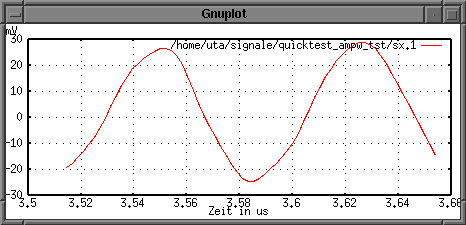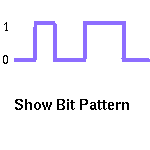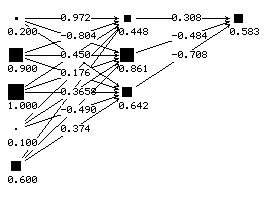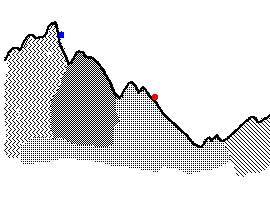 |
 |
During data storage, the changing voltage in the read-write head makes a record of the data on the magnetic surface of the disk. During data retrieval, a changing voltage is induced in the read-write head by the spinning magnetic fields on the disk surface.
A voltage "spike" is generated for each change in the bits. For example, when reading the bits 00000111111 only one spike is generated (at the location the 0s stop and the 1s begin). The direction of the spike indicates a change from 0 to 1, or from 1 to 0.
The graphic below shows a measured
induced voltage with three spikes. You can see the
bit pattern by moving the mouse pointer over the "Show Bit Pattern" image.
 |
 |
The basic structure of a neural network is given in the picture below.
 Each
box is a processing element. The number on each box (and its size) indicate
the value of each element. Each line is a connection used to pass
numeric
information from one processing element to another. The number on each
line indicates the strength of the connection, which influences how much
information is passed on. The processing elements on the very left are
the input elements, the one on the right is the output element and the
ones in the middle are called "hidden" elements.
Each
box is a processing element. The number on each box (and its size) indicate
the value of each element. Each line is a connection used to pass
numeric
information from one processing element to another. The number on each
line indicates the strength of the connection, which influences how much
information is passed on. The processing elements on the very left are
the input elements, the one on the right is the output element and the
ones in the middle are called "hidden" elements.
Let's assume we want to have a neural network which can
process electrocardiogram (ECG) information and determine whether the patient
had a light heart attack. We need to collect many different ECGs.
For each ECG we also need an expert to determine whether the patient had
a heart attack or not. We take the collected information and present
it to the network: with this ECG the answer is NO; with that ECG the answer
is YES; with yonder ECG the answer is....... What does the network
do? It guesses the answers and attempts to adjust its internal workings
such that it gets more and more answers right. In other words, it learns
from the examples presented. (This type of learning where input
and output is presented is called "supervised" learning.)
 The
example picture to the left shows an error landscape for just one connection.
If you are the red dot, going downhill will help you get to the valley.
If you are the blue dot, however, then going downhill will only lead you
into a ravine. Of course, clever as you are, you won't stay there, but
climb up the other side to eventually end up in the valley. Neural network
learning mechanisms must do the same. However, there is an inherent risk
in such behavior: since it is not known where the smallest error is, the
network might move away from it. In our little example, imagine the real
valley to be to the left of the image. Moving to the right will only get
you to the lowest spot in the picture, but not the lowest spot in the mountains.
The
example picture to the left shows an error landscape for just one connection.
If you are the red dot, going downhill will help you get to the valley.
If you are the blue dot, however, then going downhill will only lead you
into a ravine. Of course, clever as you are, you won't stay there, but
climb up the other side to eventually end up in the valley. Neural network
learning mechanisms must do the same. However, there is an inherent risk
in such behavior: since it is not known where the smallest error is, the
network might move away from it. In our little example, imagine the real
valley to be to the left of the image. Moving to the right will only get
you to the lowest spot in the picture, but not the lowest spot in the mountains.
When the bits are recorded closer and closer to each
other on the magnetic disk, the individual read "spikes" start to overlap.
Moreover, there is a non-linear interferences
among the individual spikes. On top of this there are distortions
in the induced voltage due to the movements of the read-write head (its
distance from the surface varies slightly and it oscillates slightly from
left to right). And some random background noise
also makes the pattern harder to recognize.
Below is a picture of a readsignal. The bits are recorded
with a high-density and are not that easy to detect. The left part of the
signal is still easy to decode. Try to determine the sequence of bits for
the given signal. There are six bits between dashed lines. If you want
to know the recorded bits move the cursor over the "Show Bit Pattern" area.
 |
 |
Since recognizing the individual bits becomes hard, a neural network was trained to learn to detect a bit correctly. The input to the network are measured voltages (for example 15 value), the output whether the bit in the middle (corresponding to the input value 8) is 0 or 1. Several neural network architectures have been tried and show promise.
For this research I use the neural network simulator SNNS
which was developed at the University of Stuttgart in Germany. It's available
for free, including source code. I run it from LINUX, which I installed
on my computer.